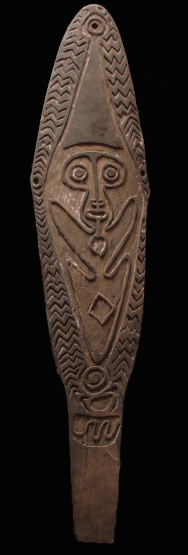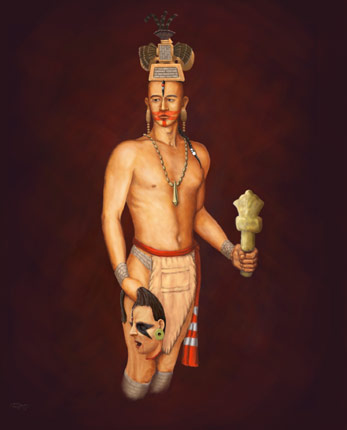|
Gope Board
A gope board (or ''kwoi'') is a wooden ritual object made in the Papuan Gulf of New Guinea. Each board represents the spirit of an ancestral hero that can protect clans from evil spirits and death. Design ''Gope'' is a term for a spiritually charged carved board made to represent an ancestral hero in the Papuan Gulf of Papua New Guinea. Papuan Gulf people of Kikori, Baimaru, Uruma, Hohao, and Orokolo refer to these sculptured boards as ''Kwoi''. The sculptures are often made from the sides of an old canoe. Use Gope sculptures are believed to protect the island clansmen from evil spirits and death A full size board is made and named by the uncle of a boy for his initiation (into adulthood) ceremony. Also, warriors are awarded gope boards for each act of bravery they perform in battle—these boards are often made from the remains of an enemy's canoe. Gope boards have a consistent elliptical shape and can vary in size up to eight feet long. They are carved in relief and ... [...More Info...] [...Related Items...] OR: [Wikipedia] [Google] [Baidu] |
Ritual Object
In the practice of religion, a cult image is a human-made object that is venerated or worshipped for the deity, spirit or daemon that it embodies or represents. In several traditions, including the ancient religions of Egypt, Greece and Rome, and modern Hinduism, cult images in a temple may undergo a daily routine of being washed, dressed, and having food left for them. Processions outside the temple on special feast days are often a feature. Religious images cover a wider range of all types of images made with a religious purpose, subject, or connection. In many contexts "cult image" specifically means the most important image in a temple, kept in an inner space, as opposed to what may be many other images decorating the temple. The term idol is a pejorative term for a cult image, except in Indian English, where it is widely accepted as a neutral English term for a murti or cult image. Idolatry is a pejorative term for the worship or excessive veneration of (mainly) cult i ... [...More Info...] [...Related Items...] OR: [Wikipedia] [Google] [Baidu] |
Papuan Gulf
The Gulf of Papua is located in the southern coast region of New Guinea. It has a total surface area of . Geography Some of New Guinea's largest rivers, such as the Fly River, Turama River, Kikori River, Purari River, and Wawoi River flow into the gulf, making it a large delta. While the western coast is characterized by swampy tidal waterways, land to the east ending at Cape Possession is flat and sandy. The Papuan Gulf's central and eastern interior slowly rises to meet the mountainous Southern Highlands, and is covered in a variety of inland swamps and dense tropical hardwood forests. The western interior possess a large region of limestone karst. The dry season begins in October and extends to February, after which the wet season starts. The southern border of the gulf is defined as a line from the southwestern corner of the Fly River Delta in the west, to Cape Suckling 355 km east of this, which is 70 km northwest of Port Moresby. This encloses a sea ar ... [...More Info...] [...Related Items...] OR: [Wikipedia] [Google] [Baidu] |
New Guinea
New Guinea (; Hiri Motu: ''Niu Gini''; id, Papua, or , historically ) is the world's second-largest island with an area of . Located in Oceania in the southwestern Pacific Ocean, the island is separated from Australia by the wide Torres Strait, though both landmasses lie on the same continental shelf. Numerous smaller islands are located to the west and east. The eastern half of the island is the major land mass of the independent state of Papua New Guinea. The western half, known as Western New Guinea, forms a part of Indonesia and is organized as the provinces of Papua, Central Papua, Highland Papua, South Papua, Southwest Papua, and West Papua. The largest cities on the island are Jayapura (capital of Papua, Indonesia) and Port Moresby (capital of Papua New Guinea). Names The island has been known by various names: The name ''Papua'' was used to refer to parts of the island before contact with the West. Its etymology is unclear; one theory states that ... [...More Info...] [...Related Items...] OR: [Wikipedia] [Google] [Baidu] |
Papua New Guinea
Papua New Guinea (abbreviated PNG; , ; tpi, Papua Niugini; ho, Papua Niu Gini), officially the Independent State of Papua New Guinea ( tpi, Independen Stet bilong Papua Niugini; ho, Independen Stet bilong Papua Niu Gini), is a country in Oceania that comprises the eastern half of the island of New Guinea and its offshore islands in Melanesia (a region of the southwestern Pacific Ocean north of Australia). Its capital, located along its southeastern coast, is Port Moresby. The country is the world's third largest island country, with an area of . At the national level, after being ruled by three external powers since 1884, including nearly 60 years of Australian administration starting during World War I, Papua New Guinea established its sovereignty in 1975. It became an independent Commonwealth realm in 1975 with Elizabeth II as its queen. It also became a member of the Commonwealth of Nations in its own right. There are 839 known languages of Papua New Guinea, on ... [...More Info...] [...Related Items...] OR: [Wikipedia] [Google] [Baidu] |
Kikori
Kikori is a small town in the Gulf Province of Papua New Guinea. Kikori lies in the delta of the Kikori River at the head of the Gulf of Papua. This area is particularly biologically rich with a diversity of ecosystems and densely forested, with an intricate system of rivers. The geography is that of limestone karst country, with clay type soils. Oil exploitation in Kikori has been operating for several years. Its first commercial oil deposits were found there by the Kutubu Joint Venture (KJV) which has since constructed a pipeline to the Gulf of Papua and is actively extracting oil from the region. It is the site of Kikori Airport. Climate Kikori has a tropical rainforest climate ( Köppen ''Af'') with very heavy rainfall year-round. Temperatures in Kikori are uniformly hot and humidity extremely uncomfortable. The town has an average annual rainfall of around ,''Merriam Webster's Geographical Dictionary, Third Edition'', p. 592 making it and surrounding Gulf Province one of t ... [...More Info...] [...Related Items...] OR: [Wikipedia] [Google] [Baidu] |
Baimuru Airport
Baimuru Airport is an airfield serving Baimuru, in the Gulf Province of Papua New Guinea. It is at an elevation of above mean sea level and has a long runway According to the International Civil Aviation Organization (ICAO), a runway is a "defined rectangular area on a land aerodrome prepared for the landing and takeoff of aircraft". Runways may be a man-made surface (often asphalt concrete, as ... designated 04/22. Airlines and destinations References External links * Airports in Papua New Guinea Gulf Province {{PapuaNewGuinea-airport-stub ... [...More Info...] [...Related Items...] OR: [Wikipedia] [Google] [Baidu] |
Headhunting
Headhunting is the practice of hunting a human and collecting the severed head after killing the victim, although sometimes more portable body parts (such as ear, nose or scalp) are taken instead as trophies. Headhunting was practiced in historic times in parts of Europe, East Asia, Oceania, Southeast Asia, South Asia, Mesoamerica, West and Central Africa. The headhunting practice has been the subject of intense study within the anthropological community, where scholars try to assess and interpret its social roles, functions, and motivations. Anthropological writings explore themes in headhunting that include mortification of the rival, ritual violence, cosmological balance, the display of manhood, cannibalism, dominance over the body and soul of his enemies in life and afterlife, as a trophy and proof of killing (achievement in hunting), show of greatness, prestige by taking on a rival's spirit and power, and as a means of securing the services of the victim as ... [...More Info...] [...Related Items...] OR: [Wikipedia] [Google] [Baidu] |
Internet Archive
The Internet Archive is an American digital library with the stated mission of "universal access to all knowledge". It provides free public access to collections of digitized materials, including websites, software applications/games, music, movies/videos, moving images, and millions of books. In addition to its archiving function, the Archive is an activist organization, advocating a free and open Internet. , the Internet Archive holds over 35 million books and texts, 8.5 million movies, videos and TV shows, 894 thousand software programs, 14 million audio files, 4.4 million images, 2.4 million TV clips, 241 thousand concerts, and over 734 billion web pages in the Wayback Machine. The Internet Archive allows the public to upload and download digital material to its data cluster, but the bulk of its data is collected automatically by its web crawlers, which work to preserve as much of the public web as possible. Its web archive, the Wayback Machine, contains hundreds of b ... [...More Info...] [...Related Items...] OR: [Wikipedia] [Google] [Baidu] |
Religious Objects
Religion is usually defined as a social- cultural system of designated behaviors and practices, morals, beliefs, worldviews, texts, sanctified places, prophecies, ethics, or organizations, that generally relates humanity to supernatural, transcendental, and spiritual elements; however, there is no scholarly consensus over what precisely constitutes a religion. Different religions may or may not contain various elements ranging from the divine, sacred things, faith,Tillich, P. (1957) ''Dynamics of faith''. Harper Perennial; (p. 1). a supernatural being or supernatural beings or "some sort of ultimacy and transcendence that will provide norms and power for the rest of life". Religious practices may include rituals, sermons, commemoration or veneration (of deities or saints), sacrifices, festivals, feasts, trances, initiations, funerary services, matrimonial services, meditation, prayer, music, art, dance, public service, or other aspects of human culture. Religio ... [...More Info...] [...Related Items...] OR: [Wikipedia] [Google] [Baidu] |
Religion In Papua New Guinea
Religion in Papua New Guinea is predominantly Christian, with traditional animism and ancestor worship often occurring less openly as another layer underneath or more openly side by side Christianity. The courts, government, and general society uphold a constitutional right to freedom of speech, thought, and belief. There is no state religion, although the government openly partners with several Christian groups to provide services, and churches participate in local government bodies. A large majority of Papua New Guineans identify themselves as members of a Christian church (96% in the 2000 census); however, many combine their Christian faith with traditional indigenous practices. Other religions represented in the country include the Baháʼí Faith, Hinduism and Islam. Christianity The 2000 census percentages were as follows: *Roman Catholic Church (27.0%) *Evangelical Lutheran Church of Papua New Guinea (19.5%) * United Church in Papua New Guinea (11.5%) *Seventh-day Adven ... [...More Info...] [...Related Items...] OR: [Wikipedia] [Google] [Baidu] |
Headhunting In New Guinea
Headhunting is the practice of hunting a human and collecting the severed head after killing the victim, although sometimes more portable body parts (such as ear, nose or scalp) are taken instead as trophies. Headhunting was practiced in historic times in parts of Europe, East Asia, Oceania, Southeast Asia, South Asia, Mesoamerica, West and Central Africa. The headhunting practice has been the subject of intense study within the anthropological community, where scholars try to assess and interpret its social roles, functions, and motivations. Anthropological writings explore themes in headhunting that include mortification of the rival, ritual violence, cosmological balance, the display of manhood, cannibalism, dominance over the body and soul of his enemies in life and afterlife, as a trophy and proof of killing (achievement in hunting), show of greatness, prestige by taking on a rival's spirit and power, and as a means of securing the services of the vic ... [...More Info...] [...Related Items...] OR: [Wikipedia] [Google] [Baidu] |







.jpg)